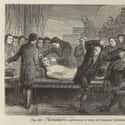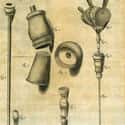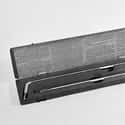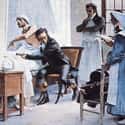-
(#10) Electrically Shocking The Face
Galvanism, or the process of using electricity to cause muscle contractions, was cutting-age science in the early 18th century. Scientist Luigi Galvani proclaimed that electricity was the force of life in 1791, and the technique even inspired Mary Shelley’s Frankenstein. So it’s no wonder that doctors came up with a galvanism death test.
In 1805, Christian August Struwe suggested using electricity to shock a corpse’s eye and lip – if the person was still alive, there would be a muscle twitch. Unfortunately, the equipment was so expensive that the galvanism death test did not catch on – in spite of images that implied the test was foolproof.
-
(#2) Funneling A Tobacco Smoke Enema Up Someone's Rectum
Who knew all the uses of tobacco? The tobacco smoke enema was a surefire way of reviving drowning victims in the late 18th century. Starting around 1774, “pipe smoker London Medics” would insert an enema tube into a drowning victim and blow smoke into the rectum.
The device was thought to work two ways: it would warm the body, and it would stimulate respiration. But the tobacco smoke enema had its dangers, too: if the medic accidentally inhaled instead of exhaling, he might breathe in cholera and kill himself. Eventually, practitioners introduced a bellows so that medics didn't have to blow smoke directly up people’s bums.
-
(#6) Sticking A Thermometer In The Corpse's Stomach
One surefire way to determine if a person was really dead was using a thermometer. But in the 19th century, doctors didn’t mess around with an under-the-tongue measurement. In 1841, Christian Friedrich Nasse developed a thanatometer – a long thermometer that could be inserted into the corpse’s stomach. The thermometer could then measure the core body temperature to determine if life was possible.
Of course, shoving a thermometer into the person’s stomach might also cause a reaction if the person wasn’t actually dead.
-
(#5) Chopping Off A Finger
Many 18th and 19th-century death tests involved fingers. One gruesome way to test for death was chopping off a person’s finger. It was thought that the shock might bring a body back to life – or prove that the person was actually dead. Other tests involving fingers included holding them over a candle flame or looking for blood circulation at the finger tips. At least that sounds less painful than having a finger chopped off.
-
(#8) Rhythmically Pulling The Tongue For Three Hours
If manipulating the tongue helped during artificial respiration, why not tug on it to see if a corpse was actually dead? That was the suggestion from Dr. J.V. Laborde, who recommended rhythmically pulling the deceased’s tongue for three hours.
According to Laborde, he had once successfully revived an unconscious woman by yanking her tongue with strong forceps. The woman complained that the pain was excruciating, but at least she was alive. Laborde even invented a tongue-pulling machine for mortuaries. Even unskilled mortuary assistants could turn the crank, determining whether a body was truly dead before it was buried.
-
(#11) Using The Gases Released By The Body To Reveal Invisible Ink
Doctor Séverin Icard came up with a death test in the late 19th century that almost seemed like a magic trick. Icard used acetate of lead to write the phrase “I am really dead” on a piece of paper. The words were invisible until he placed the paper on the corpse’s nose. If the body was releasing sulfur dioxide, present in putrefactive gases, the invisible words would appear on the paper like magic.
However, in a time before modern dentistry, decaying teeth or tonsillitis could also create sulfur dioxide, creating false positives.
New Random Displays Display All By Ranking
About This Tool
Their bodies did not rot and even still warm, their stomachs gurgled and blood was still flowing. However, according to most medical assessments, these patients have completely died. is it possible? How did the doctor determine that they were actually dead? Confirming death is not easy. In Europe in the 18th century, people had more than 30 methods for making sure a corpos was dead, including clamping the nipple with pliers and putting leeches into the human anus.
It is certain that modern medical institutions do not think these methods are convincing. Over the centuries, humans have initiated a series of revolutionary new technologies to confirm death. The random tool brings us back to the 18th century to explore 14 weird ways to make sure the corpses were dead.
Our data comes from Ranker, If you want to participate in the ranking of items displayed on this page, please click here.
















